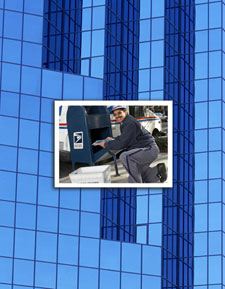mail — the real kind:
technology at work.

5 p.m....everyday...like clockwork..right in front of my building...the Postal Service keeps our appointment and picks up my mail...We've got to keep meeting like this! |
Think about it. Every day, the United
States Postal Service delivers more than
650 million letters, cards, magazines,
packages and catalogs to more than
141 million American families and businesses.
It's a big job. It's an important job. And
it's our goal to do it accurately, on time
and on budget — yours and ours.
We start with 729,000 of the most
dedicated career employees in the
nation. We add a liberal dose of technology
to cancel stamps, sort the mail and
get it ready for delivery. It sounds simple,
but it's not.
With a mail volume that's more than
doubled in the last 25 years, technology
has never been more important to the
Postal Service. It's helped us manage
costs, improve productivity and keep
prices affordable. In fact, the cost of
today's First-Class stamp, adjusted for
inflation, is less than the 15-cent stamp
of 1979.
It all starts when you drop a letter into
any one of over 300,000 street collection
boxes, at any of our more than 37,000
Post Offices, or hand it to your letter
carrier. From there, your mail begins its
incredible journey through the world's
most advanced mail-processing environment.
First stop? State-of-the-art automated
processing equipment that faces each
letter in the same direction and applies
your postmark to each stamp. From
there, our sortation control system helps
move mail to the right equipment or
processing location.
For letters, our sorting equipment
reads the address, checks it against our
master address list and applies a
barcode identifying the Post Office that
will deliver the letter and the individual
carrier route that serves the address.
And it does this quicker than the blink of
an eye.
And our world-class handwriting recognition program allows equipment to read the addresses on almost 85 percent of the letters we handle. Of course, not everyone earned an "A" in penmanship. So some letters need a little extra work. But we're ready for them. Our remote bar coding system captures a video image of the envelope and transmits
it to a centralized, remote encoding
site, often hundreds of miles away. There,
operators

|
enter address information, and
we can apply a bar code to the envelope
and keep it moving through our automated
processing system.
If your letter is for local delivery, the mail is sorted and transported to the delivery Post Office. But for mail going farther, we've got to prepare it for long-distance transportation. So, before it leaves the local processing facility, mail is put into trays according to its destination. Then it passes through equipment that checks the address and assigns it to the right airline flight or surface transportation so that it gets delivered on time.
From there, it's almost home. Once
your mail gets to a processing facility
serving the delivery Post Office, it gets
sorted again — either to the delivery
Post Office or right to the carrier route.
This is where those bar codes really
come in handy. Delivery-point automation
takes over, reads the codes and
sorts your mail into the order your letter
carrier will deliver it. Quickly. Easily.
Accurately.
Similar technology does many of the
same tasks for packages, larger
envelopes, catalogs and magazines.
And that's not all. We're bringing advanced technology to our mail-forwarding system, too. Even if your college roommate doesn't know you moved, we'll make sure your birthday card finds you — before it becomes a belated "Best Wishes!" So, if you've filed a change-of-address notice, we'll program that into our address database. And in many areas, when your card gets processed, our equipment will know you moved and get it to the right address. No muss. No fuss. And no delay. That's because we won't have to send your card to your old Post Office to correct the address and then forward it.
Your mail is important to you. It's important to us. That's why the men and women of the United States Postal Service — supported by the latest and best technology — will continue to provide you with an unparalleled tradition of service. It's what we do.

|




